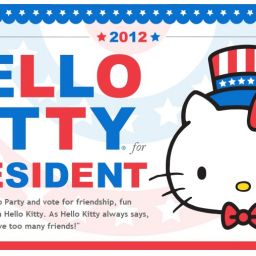By Keidra Chaney
There was a point, believe it or not, where an individual “aged out” of Hello Kitty, at least here in the United States. I remember several years ago there was a reality TV show with singer/songwriter Lisa Loeb, and I remember how her own Hello Kitty fixation was used as kind of a running joke for the show (annoyingly at her expense) – haha, this woman in her mid-30’s collects Hello Kitty, what’s wrong with her? Since then, or perhaps at about the same time, Hello Kitty and Sanrio went through a reinvention of sorts, whe
The exhibit Hello! Exploring The Supercute World of Hello Kitty (now at Seattle’s EMP Museum until May 15, 2016) explores HK’s evolution as a brand and on her influence on pop culture, art, and even the identities of her young and old fans. Befitting Hello Kitty’s multifaceted influence, the exhibit represents her in art and commerce: one part of the exhibit features the variety of Sanrio/Hello Kitty products – from plus toys to toaster, mini fridges and, er … “back massagers” and the other half of the exhibit includes Hello Kitty-influenced clothing and mixed-media installations from artists.
There’s a lot to see and “ooh” over, but I was hoping for a bit of a deeper dive; hardcore Sanrio devotees and collectors will already be familiar with many of the products featured in the exhibit; much of the fashion featured are items available for sale or were featured in an episode of reality show America’s Next Top Model. (I was personally a bit disappointed that the exhibit didn’t include clothes from the Hello Kitty themed episode of RuPaul’s Drag Race from a couple of seasons ago; the clothes there were a bit more daring, and just showing them could have delved into issues of gender/sexuality, race, and more.) However, the exhibit doesn’t shy away from critique; it even references Hello Kitty backlash: those who push back against HK as a symbol that references a stereotype of Asian women as docile or weak.
I would have loved to have seen more of this focus in the exhibit; how Hello Kitty as a blank slate symbol has been used, appropriated and even subverted through the lens of race, gender, culture, and age. Hello Kitty seems to mean something different to these different groups, she’s innocent, and edgy, both global and very Japanese, and well-loved by many while still maintaining a level of mystery. Many global consumers don’t see HK as a symbol of anything, the way we see, say Mickey Mouse as the face of Disney. HK doesn’t belong to Sanrio, her parent company, she’s just herself. In a hyper-branded world, that’s fascinating and rare, and to dig deeper into that in exhibit form would be fascinating.
We’ve written a bit about the cultural impact of Hello Kitty on TLF in previous posts, and we were very excited to see how the EMP exhibit would approach this topic. While I overall enjoyed, there’s a couple more layers of critical inquiry that could have been delved into. It’s a great, very family friendly and kid appropriate look at the history and cultural impact of Hello Kitty, but I would love to have seen how this exhibit might be explored via a curator with a critical/cultural studies lens. Nonetheless, if you are an HK fan or you’re the parent of one, it’s worth checking out.



